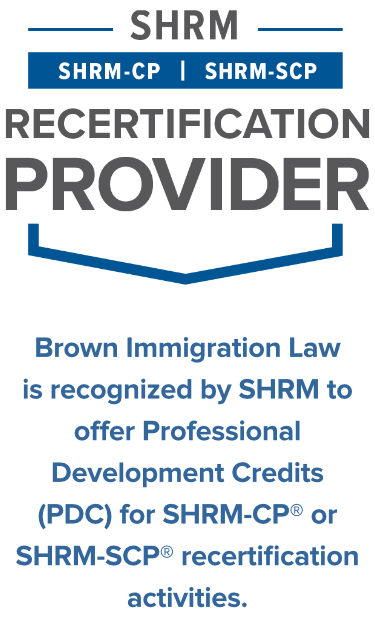Applicants for employment-based permanent residence (i.e., the “Green Card”) can apply for permanent residence in one of two ways: Adjustment of Status, where the applicant applies by mail while remaining in the U.S, or Consular Processing, where the applicant applies for an immigrant visa in his or her home country. Those in the process of submitting the I-140 Immigrant Petition should consider these options – Adjustment of Status or Consular Processing – as soon as possible in the process. Individuals with approved I-140 petitions may also wish to revisit these options again before applying for the final stage of permanent residence, as current processing times and personal factors may have changed since filing the immigrant petition. The purpose of this memo is to outline the steps involved in adjustment of status and consular processing and provide some information about the advantages and disadvantages of each method of processing.
A choice of Adjustment of Status or Consular Processing must be entered on Form I-140, Immigrant Petition for Alien Worker. There is always an opportunity to change your election after the fact and choose the other process. However, to avoid possible processing delays and increased fees, it is best to take this election seriously.
The primary concern of most applicants is: “Which is the fastest way to permanent residence?” While getting permanent residence as quickly as possible is important, several other factors must be considered when deciding which is the better route. The purpose of this memo is to describe the two processes, and to set forth the possible advantages and disadvantages of each process.
Adjustment of Status
Steps:
Step 1: Form I-140, Immigrant Petition for Alien Worker, is filed with the U.S. Citizenship and Immigration Services (USCIS), requesting Adjustment of Status.
Step 2: If a visa number is available, applicant can concurrently file Form I-485, Application to Register Permanent Residence or Adjust Status and process the applications in one step. If subject to immigrant visa backlogs applicant will have to wait until they are eligible to file the adjustment of status.
Step 3: The applicant applies to adjust status with the appropriate USCIS service center, submitting the Approval Notice for the I-140 Immigrant Petition (or filed concurrently with the I-140), results of a medical exam, and other documentation of eligibility, identity, and maintenance of U.S. status.
Step 4: After the adjustment application is filed, the applicant is scheduled for fingerprinting at a local USCIS Field Office/Application Support Center.
Step 5: The decision on an Adjustment of Status application comes by mail (following approval of I-140, if filed separately or together).
Step 6: USCIS mails the Permanent Resident Card to the applicant within 30 days.
Advantages of Adjustment of Status:
- May avoid some admissibility issues, and thus may be appropriate for persons currently in the U.S. who have at some time lapsed in U.S. status, worked without authorization, or otherwise failed to maintain conditions of admission.
- USCIS decisions may be appealed; applicant (and any family members also applying for adjustment) may be able to remain in the US until a final decision is reached.
- Employment authorization is available after approximately 90 days to applicants (and all family members applying to adjust who are over 14) while application is pending, and may be renewed annually. Even if applicant exhausts available time in H or L status, s/he may be able to remain in the U.S., work legally, and travel, while the adjustment application is pending.
- USCIS interviews of employment-based applicants are rare.
- If an interview is scheduled, applicant has the right to counsel at interview.
- Involves only one government entity, reducing chance for governmental red tape, intra-departmental or international complications.
- Green card portability: Adjustment of Status applicants whose I-485 applications have been pending for 180 days or more can change jobs or employers, as long as the new job is in the “same or similar occupational classification” as on the original labor certification and/or I-140 petition. This permits transfer within the employer’s organization and the option of continuing a green card application with a new employer in the event of a layoff.
- 7th year H-1B extension: Adjustment of Status applicants who have a labor certification or I-140 petition filed one year or more prior to their H-1B six-year maximum can extend H-1B status in one year or three year increments until adjudication of the I-485 is complete. (The extensions would end if the labor cert or I-140 were denied and not appealed.
- Concurrent filing option: The USCIS now allows applicants to file the I-140 petition and I-485 application at the same time (assuming the immigrant visa number is available.) Concurrent filing allows applicants to apply for employment authorization and advance parole earlier than if they waited for the I-140 to be approved. Concurrent filing could save considerable time, as the I-485 application will already be “pending” for the time it takes to adjudicate the I-140 Immigrant Petition. Note: there may be risks involved for those filing highly discretionary I-140 petitions in categories such as Outstanding Researchers.
Disadvantages of Adjustment of Status:
- If applicant has any criminal or immigration violations, s/he may not be eligible for adjustment of status. For example, if the applicant has worked without authorization, or been “out of status” for 180 days or longer, s/he may not be eligible for adjustment of status, and may need to apply for consular processing.
Consular Processing
Steps:
Step 1: Form I-140, Immigrant Petition for Alien Worker, is filed with USCIS, requesting consular processing.
Step 2: Upon approval of the I-140, USCIS sends notice of approval to the State Department’s National Visa Center (NVC). Learn more about NVC employment-based immigrant visa processing here.
Step 3: If a visa number will be available for the applicant in the next year (varies by nationality and category of immigrant visa), NVC sends a fee bill for Immigrant Visa processing to the applicant/attorney of record (generally within 2 months).
Step 4: Once payment is processed, NVC will forward an instruction packet (formerly called Packet 3) with forms and list of supporting documents to be submitted by applicant:
- Applicant must complete online form DS-260, Online Immigrant Visa Application.
- Applicant must provide the applicable Civil Documents — Birth Certificate, Police Certificates, Photocopy of Passport ID page, Photographs, and any Marriage or Divorce Certificates, Court/Prison Records, Deportation Documents, Military Records, Petitioner Documents, and/or Adoption documentation.
- Applicant pays any necessary Affidavit of Support fees and completes Affidavit of Support forms (only applicable if a relative filed the immigrant visa petition or has a 5% or greater ownership interest in the business that filed the petition).
Step 5: Upon return of completed forms and civil documents, the NVC forwards the application to the appropriate consulate abroad.
Step 6: The consulate sends the applicant further instructions, information on the required medical exam, and an appointment for interview (formerly called Packet 4). Applicant must have a medical exam overseas with a physician on the consulate’s list. Instructions will vary by consulate/embassy.
Step 7: Applicant (and all family members also applying) must travel to consulate for interview and to have a medical exam completed in the foreign country. If all vaccinations are current, this is generally completed in four to seven days. Once the interview is completed, if consulate approves the application for immigrant visa, applicant is given paperwork to present upon entry to the U.S. The applicant becomes a U.S. Permanent Resident upon entry to the U.S. using the immigrant visa, and a temporary “green card stamp” is received in the Passport upon entry. USCIS takes additional photo and fingerprints for production of the final green card.
Step 8: USCIS mails the U.S. Permanent Resident Card to the applicant within 30 days.
Advantages of Consular Processing:
- May be advantageous for applicants who want to process at the same time as family members who are currently living abroad.
Disadvantages of Consular Processing:
- Raises issues of admissibility: if applicant has stayed beyond a period authorized by the Attorney General on Form I-94, s/he may be barred from entering the U.S. for up to 10 years[1].
- No employment authorization is available while application is pending, so family members applying with principal applicant cannot work. If applicant uses up available time in H or L status, s/he must leave the U.S. and complete consular processing before returning.
- Applicant must get police certificate from each country of residence since age 16.
- Always results in in-person interview by consular officer.
- Some consulates may not give right to counsel at the interview.
- There is no appeal or other administrative review available to challenge a negative decision by the consulate.
- Processing times and success rates vary from country to country. High admission/flight/fraud posts may require additional documentation/verification; immigration may be subject to political climates and local attitudes.
- Availability of appointments depends on the individual consulate.
- Applicants may only consular process in their country of birth, country of chargeability, or country of citizenship or other permanent residence (as defined by the consulate).
- In rare cases, may require multiple trips abroad to complete process – a less than successful interview may result in a request for additional evidence, and a subsequent interview, often two weeks or more after first interview, at the consulate’s discretion.
- All family members are required to apply at consulate, and the interviews are set at the consulate’s discretion with three to four weeks notice. In addition to the travel costs, attending the interview may interrupt education and employment.
- Green card portability is not available.
- Concurrent filing with the I-140 Petition is not available.
- With the increased speed of Adjustment of Status, this process is generally slower.
What Happens If You Change Your Election?
So what happens if the applicant changes his or her mind after filing Form I-140? The answer to that question depends on the initial choice. If the applicant chooses Adjustment of Status on the I-140 and later decides to Consular Process, s/he must file Form I-824 with the appropriate USCIS service center, and wait until the receipt notice is received (three to four weeks). Many consulates may require approval of the Form I-824 (processing time vary, and may take over six months) before Consular Processing can begin. Increasingly, Consulates are taking jurisdiction over cases with simply proof of I-824 filing. If the applicant chooses Consular Processing and later decides on Adjustment of Status, the I-485 Adjustment of Status form can be filed, noting the change. Generally the USCIS will send a letter acknowledging the change and requesting confirmation of the new choice of Adjustment of Status. The Consular Processing will be cancelled and the file transferred from the NVC to the Service Center adjudicating the application. In either scenario, expect the change in the election to add several extra months to the usual processing times. And a general reminder, technically an applicant may not pursue both Adjustment of Status and Consular Processing for the same I-140 petition at the same time; although this has reportedly been done.
** This memo is provided for informational and discussion purposes only. It does not act as a substitute for direct legal contact on an individual basis **
[1] See INA § 212(a)(9)(B)(i)(I) subjecting those unlawfully present in the U.S. for a period of more than 180 days but less than one year, to a three-year bar to admission; or INA § 212(a)(9)(B)(i)(II) subjecting those unlawfully present in the U.S. for a period of one year or more to a ten-year-bar to admission. Certain tolling provisions apply; check with our office if you have questions.



